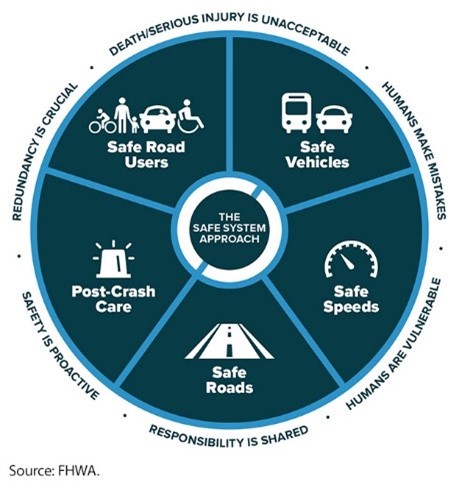Are frequent accidents happening due to the deteriorating condition of your roads? There are funds for you, your county and state to utilize to enhance road conditions and reduce fatalities. These funds are called Highway Safety Improvement Program funds (HSIP).
The Highway Safety Improvement Program is a Federal-aid program to reduce traffic fatalities on all public roads, including non-state-owned roads and roads on tribal land. HSIP funds are eligible for any highway safety improvement project on any public road or publicly owned pedestrian/bicycle pathway or trail.
The Safe System Approach
The Safe System approach is a worldwide movement that has been in place for more than 30 years. The Federal Highway Administration’s (FHWA) top priority is safety and recognizes that HSIP aids funding this safe system and sets the tone for safety implementation across agencies.
The Safe System approach consists of five elements: safe road users, safe vehicles, safe speeds, safer roads and post-crash care. Within this system, all five elements must be achieved otherwise safety will be breached.

- Safe Road Users: To ensure the safety of the road user, the approach expects that the road system is to be designed and operated in a way that is to forgive human mistakes. For example, rumble strips are installed to help keep drivers awake and prevent crashes.
- Safe Vehicles: This element trusts that vehicles are designed and regulated to minimize collisions and have safety measures in place to protect the vehicle user, like air bags and seat belts.
- Safe Speeds: This element focuses on the reduction of speed, which is based on the vehicle operator. It includes providing additional time for stopping, turns, and reducing the risk of collision.
- Safe Roads: This element is where HSIP funds come into play. It highlights the ability to have safe roads for users through designing safe transportation infrastructure to accommodate mistakes and reduce crashes.
- Post-Crash Care: This last element focuses on the resources like emergency first responders available to those who experience crashes, and how easily they can access them.
Eligibility
To become eligible to use HSIP funds, your project must address a priority in the Strategic Highway Safety Plan (SHSP), be identified through a data-driven process, targets an identified safety problem and contribute to a reduction in fatalities and serious injuries.

- Addresses a priority in the SHSP: The SHSP is a federally required plan that includes a framework for safety stakeholders to reduce fatalities and injuries on public roads. To be eligible for HSIP funding, the project must have a priority that is also addressed through that states SHSP.
- Identified through a data-driven process: This simply means that the project was chosen based on an analytic aspect including crash experience, crash rate, or other data that is supported by a hot spot analysis or a risk-based system approach.
- Targets an identified safety problem: The project chosen must solve a safety problem identified through the data-driven process.
- Contributes to a reduction in fatalities and serious injuries: There are research-based countermeasures that help guide how such projects can reduce fatalities and serious injuries. The project selected must help contribute to this.
The HSIP legislation under 23 U.S.C. 148 (b)(2) provides a list of example highway safety improvement projects that can help guide you in deciding if your project may qualify or not. Eligibility may differ from state to state, so it is helpful to check with your State DOT. You can view example projects in the state of Indiana here.
How to Apply
Each state differs for the application process for HSIP funding, so contact the state DOT to identify HSIP application resources. Agencies can then coordinate with the state’s HSIP manager to identify these resources.
To conclude, safe roads are not just a matter of convenience, they are a fundamental aspect of public safety and well-being. Every individual using our roadways deserves the assurance of reaching their destination safely. By taking proactive measures like utilizing HSIP funding, we can improve road conditions while also saving lives. You can make those infrastructure dollars go even farther by combining them with innovative applications such as J-Band® and centerline rumble strips.
To see HSIP dollars in action you can click here to read more about them being utilizing in Jersey County, Illinois on Otterville Road. For additional HSIP related resources including videos, training, and webinars, click here.
Sources
Doctor, M., & Ngo, C. (2022). Making our roads safer through a safe system approach. Making our Roads Safer through a Safe System Approach | FHWA. https://highways.dot.gov/public-roads/winter-2022/01#:~:text=The%20Safe%20System%20Approach%20considers,requires%20strengthening%20all%20five%20elements.
U.S. Department of Transportation Federal Highway Administration. (2024, February 2). Highway Safety Improvement Program (HSIP). Highway Safety Improvement Program (HSIP) | FHWA. https://highways.dot.gov/safety/hsip
U.S. Department of Transportation Federal Highway Administration. (2015, July 13). Highway Safety Improvement Program – PROJECT ELIGIBILITY – safety: Federal Highway Administration. Highway Safety Improvement Program–Project Eligibility. https://safety.fhwa.dot.gov/hsip/resources/fhwasa15011/
U.S. Department of Transportation Federal Highway Administration. (2023, January 18). Strategic Highway Safety Plan (SHSP). Strategic Highway Safety Plan (SHSP) | FHWA. https://highways.dot.gov/safety/hsip/shsp


